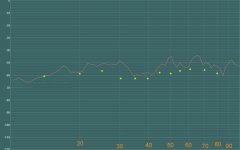I've read of some people claiming that as there are losses due to air leaks, non solid walls etc, as JohninCR stated, that an ebs type ported sub is a much better match for real world flat response. Indeed if I was to ebs my tempests I probably wouldn't need to eq them (for boost at least - only to flatten)
Yep, at some point you reach the structure's various resonant modes, turning the structure into a variable Q broadband diaphramatic absorber below the 1st axial mode (~565 ft/longest dim.).
Way back when, I had a dual HE 15" driver 150 ft^3 false wall IB/channel. I figured that since Altec's chief engineer chose IB for his home HI-FI then it must be the best design. I was getting Altec's engineering tech letters back when T/S began sweeping through the audio community so got up to speed fairly early on, and in one of them they had a section on non-Thiele alignments including one called 'X' BASS that intrigued me enough to do some experimentation. I found that it was best suited to flattening out the booming responses caused by driving T/S max flat alignments with a high output impedance amp. For sure they couldn't compete with the IBs when the source demanded extended LF BW, but the results spurred me on to try more radial alignments.
As I continued to lower F3 I found an Fb where the shelved response was a better 'fit' overall to my room compared to the IBs if there was enough cab Vb, especially down low where the boost from the peaking Fb somewhat offset the rapid roll off of my typical S.E. region home's construction. Enamored with this new insight combined with a neighbor that wanted to extend the LF response of my old A7s he'd purchased, I modded the cabs to include Altec's then new high excursion 15" woofer which was designed to be used in a sealed cab.
Corner loaded, they were pretty awesome even by today's lofty standards, easily outperforming my old IBs down low since they each had far more low distortion excursion/power handling than two of my old theater horn drivers. Since I didn't know that you're not supposed to vent a driver meant to be used in a sealed alignment, I began playing with different vent lengths and found one that yielded audibly better results, which turned out to be tuned to around 16 Hz.
Anyway, over time I found that a ~14-16 Hz Fb worked really well in all but the largest rooms I designed/built for and had the added benefit of being the ~ideal loading for the few special effects and organ music RTR tapes I had. To me they sound as good as an IB, but with more gain. If sims are to be believed, then when tuned this low they have as good an impulse response (group delay) in the audible passband as the same driver in an IB, so maybe my ears are telling me the truth.
Cabs have to be large compared to a typical T/S alignment (my two are 20 ft^3 Vs a max flat 6 ft^3), but are far smaller than a false wall IB and with a handtruck are portable, so other than my brief fling with a pair of DIY SD Contrabasses, 16 Hz EBS cabs have been my sub system of choice for several decades.
With the ~recent availability of ~inexpensive, space efficient, low Fs, high Xmax drivers and ~inexpensive amps/EQ, a number of small sealed cabs EQ'd flat makes much more sense to me than one or two expensive/super high Xmax drivers driven with amps whose wattage rating rivals a small town's power station, or a fixed multiple driver IB unless you have a suitable large space to install it and SAF issues that dictate a hidden sub system.
For HT or multi-channel music, multiple small subs is the no-brainer choice IMO, with one for each channel plus possibly more than one for the LFE, but all wired off the LFE with mains set to 'small' for the other channels.
As always though, YMMV.
GM
tiroth said:
Do you feel that RTA'd pink noise is the best measurement technique for the bottom octave? I've never been able to match 1/30 octave warbles to 1/30 octave pink noise RTA, and haven't any idea which is more accurate.
Ordered the stryke test cd just after I replied to this. Just arrived.
Pink noise versus warble tones/spl meter readings.
Not bad - the curve does follow. Ignore that the pink noise is above the spl plots. Just used the 15Hz reading as a 'zero' for both. Should have used 60 / 70 Hz really. Only 30 Hz is way out...
Cheers.
Rob
Attachments
- Status
- Not open for further replies.
